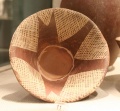Naqada I dell'Egitto
Da Ufopedia.
(→Galleria immagini) |
(→References and notes) |
||
| (15 revisioni intermedie non mostrate.) | |||
| Riga 1: | Riga 1: | ||
{{Tradurre}} | {{Tradurre}} | ||
| - | |||
The '''Amratian Culture''' was a cultural period in the history of [[Predynastic Egypt|predynastic]] [[Upper Egypt]], which lasted approximately from 4000 to 3500 BC.<ref>{{cite book |editor-last=Shaw |editor-first=Ian |title=The Oxford History of Ancient Egypt |year=2000 |publisher=Oxford University Press |isbn=0-19-815034-2 |page=479 }}</ref> It is named after the site of [[El-Amra]], about 120 km south of [[Badari]], [[Upper Egypt]]. El-Amra was the first site where this culture group was found without being mingled with the later [[Gerzean culture]] group. However, this period is better attested at the [[Naqada]] site, thus it also is referred to as the '''Naqada I''' culture.<ref>Grimal, Nicolas. ''A History of Ancient Egypt.'' p.28. Librairie Arthéme Fayard, 1988</ref> Black-topped ware continued to be produced, but white cross-line ware, a type of pottery which has been decorated with close parallel white lines being crossed by another set of close parallel white lines, begins to be produced during this time. The Amratian period falls between S.D. 30 and 39 in Petrie's [[Sequence Dating]] system.<ref name="Gardiner 390">Gardiner, Alan, ''Egypt of the Pharaohs'' (Oxford: University Press, 1964), p. 390.</ref> | The '''Amratian Culture''' was a cultural period in the history of [[Predynastic Egypt|predynastic]] [[Upper Egypt]], which lasted approximately from 4000 to 3500 BC.<ref>{{cite book |editor-last=Shaw |editor-first=Ian |title=The Oxford History of Ancient Egypt |year=2000 |publisher=Oxford University Press |isbn=0-19-815034-2 |page=479 }}</ref> It is named after the site of [[El-Amra]], about 120 km south of [[Badari]], [[Upper Egypt]]. El-Amra was the first site where this culture group was found without being mingled with the later [[Gerzean culture]] group. However, this period is better attested at the [[Naqada]] site, thus it also is referred to as the '''Naqada I''' culture.<ref>Grimal, Nicolas. ''A History of Ancient Egypt.'' p.28. Librairie Arthéme Fayard, 1988</ref> Black-topped ware continued to be produced, but white cross-line ware, a type of pottery which has been decorated with close parallel white lines being crossed by another set of close parallel white lines, begins to be produced during this time. The Amratian period falls between S.D. 30 and 39 in Petrie's [[Sequence Dating]] system.<ref name="Gardiner 390">Gardiner, Alan, ''Egypt of the Pharaohs'' (Oxford: University Press, 1964), p. 390.</ref> | ||
| Riga 12: | Riga 11: | ||
Immagine:Egypte_louvre_313.jpg | Immagine:Egypte_louvre_313.jpg | ||
Immagine:El-Amra_cattle_british_museum.jpg | Immagine:El-Amra_cattle_british_museum.jpg | ||
| - | Immagine: | + | Immagine:Figures_d27ossos_i_ivory_al_museu_britC3A0nic2C_londres.jpg |
| - | Immagine: | + | Immagine:Hippo_shaped_cosmetic_palette.jpg |
| - | Immagine: | + | Immagine:Naqada_sculpture_Louvre_E27457.jpg |
| - | Immagine: | + | Immagine:Negade_I_vessels.jpg |
| - | Immagine: | + | Immagine:Negade_II_amulett.jpg |
| - | Immagine: | + | Immagine:Predynastic_bearded_man-MGR_Lyon-IMG_9928.jpg |
| - | Immagine: | + | Immagine:WLA_brooklynmuseum_Hippopotamus_Tusk_with_Carved_Head.jpg |
| - | Immagine: | + | Immagine:C384gyptisches_Museum_Berlin_012.jpg |
| - | Immagine: | + | Immagine:C384gyptisches_Museum_Berlin_061.jpg |
| - | Immagine: | + | Immagine:C384gyptisches_Museum_Berlin_062.jpg |
| + | Immagine:C384gyptisches_Museum_Leipzig_029.jpg | ||
</gallery> | </gallery> | ||
| Riga 27: | Riga 27: | ||
<references /> | <references /> | ||
| - | [[Categoria: | + | [[Categoria:Periodi egizi]] |
Versione attuale delle 10:45, 23 giu 2016
| Questa voce ha bisogno di essere tradotta. |
The Amratian Culture was a cultural period in the history of predynastic Upper Egypt, which lasted approximately from 4000 to 3500 BC.[1] It is named after the site of El-Amra, about 120 km south of Badari, Upper Egypt. El-Amra was the first site where this culture group was found without being mingled with the later Gerzean culture group. However, this period is better attested at the Naqada site, thus it also is referred to as the Naqada I culture.[2] Black-topped ware continued to be produced, but white cross-line ware, a type of pottery which has been decorated with close parallel white lines being crossed by another set of close parallel white lines, begins to be produced during this time. The Amratian period falls between S.D. 30 and 39 in Petrie's Sequence Dating system.[3]
Trade between Upper and Lower Egypt is attested at this time, as new excavated objects attest. A stone vase from the north has been found at el-Amra, and copper, which is not present in Egypt, apparently was imported from the Sinai, or perhaps from Nubia. Obsidian[4] and an extremely small amount of gold[3] were both definitively imported from Nubia during this time. Trade with the oases also was likely.[4]
New innovations such as mud-brick buildings for which the Gerzean period is well known also to begin during this time, attesting to cultural continuity. However, they did not reach nearly the widespread use that they were known for in later times.[5] Additionally, oval and theriomorphic cosmetic palettes appear to be used in this period. However, the workmanship was still very rudimentary and the relief artwork for which they were later known is not yet present.[6]
Galleria immagini
References and notes
- ↑ Template:Cite book
- ↑ Grimal, Nicolas. A History of Ancient Egypt. p.28. Librairie Arthéme Fayard, 1988
- ↑ 3,0 3,1 Gardiner, Alan, Egypt of the Pharaohs (Oxford: University Press, 1964), p. 390.
- ↑ 4,0 4,1 Grimal, Nicolas. A History of Ancient Egypt. p.28. Librairie Arthéme Fayard, 1988
- ↑ Redford, Donald B. Egypt, Canaan, and Israel in Ancient Times. (Princeton: University Press, 1992), p. 7.
- ↑ Gardiner, Alan, Egypt of the Pharaohs (Oxford: University Press, 1964), p. 393.













